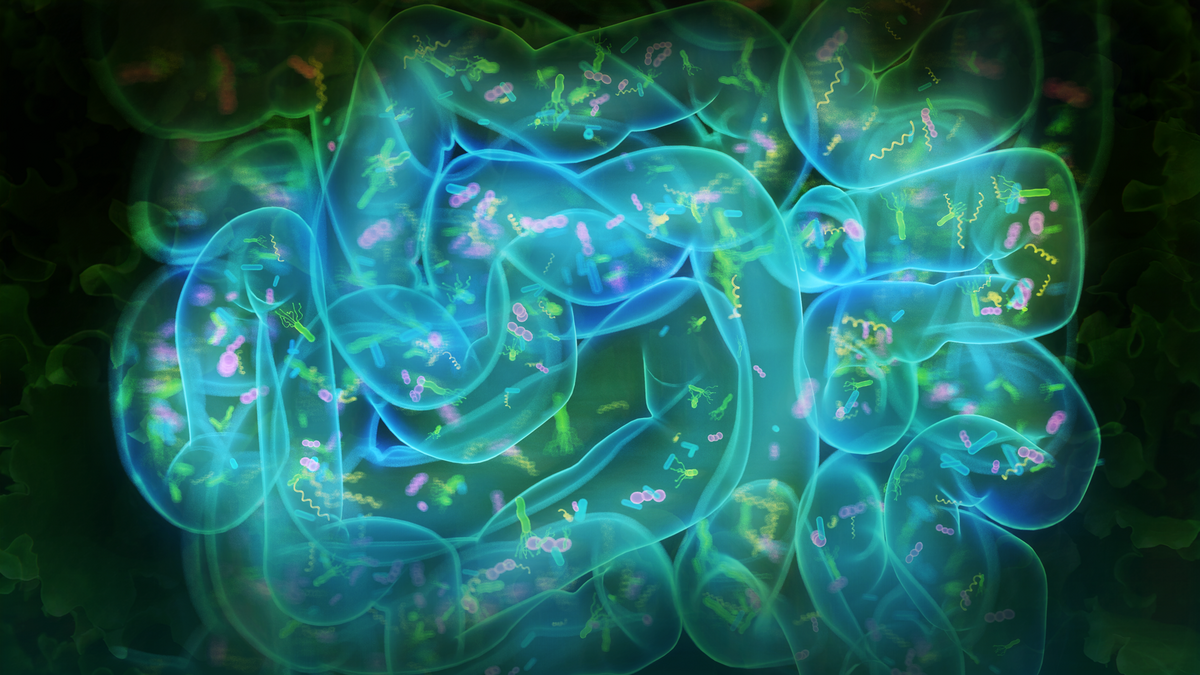Health-conscious consumers often select their foods based on calorie content. Yet, new evidence suggests they may be missing a critical piece of the puzzle.
In an unprecedented study, scientists reveal that the impact of calories on nutrition and body weight isn't consistent across the board. Contrary to a longstanding belief, not all calories are created equal — especially in the context of the bacterial communities inhabiting the gut. In fact, the effect calories have on the body can differ substantially, depending on the foods they come from.
The new study, appearing in the journal Nature Communications, found that the body reacts differently to calories ingested from high-fiber whole foods versus processed foods.
The findings show that more processed foods, which are rapidly absorbed in the upper gastrointestinal tract, provide more calories to the human body, leaving fewer calories for the gut microbiome. In contrast, high-fiber whole foods make their full journey down the digestive tract to the large intestine, where they nourish the trillions of bacteria that constitute the gut microbiome.
The new data represent a promising step forward in understanding the complex relationship between diet, gut microbiota and health, suggesting that adopting a healthy and fiber-rich diet could potentially combat obesity, promote metabolic health and improve general well-being.
“Our main objective was to send more energy to the microbes, to shed light on the contribution of the microbiome to energy extraction in a well-controlled setting with very defined measurements,” said Rosa Krajmalnik-Brown, a co-author of the new study. “We showed that our microbiome enhancer diet worked as planned, sending more energy to the gut microbes.”
Krajmalnik-Brown directs Arizona State University's Biodesign Center for Health Through Microbiomes and is a professor in the School of Sustainable Engineering and the Built Environment. She and Dr. Steven Smith with AdventHealth Translational Research Institute of Metabolism and Diabetes in Orlando planned the design of this study and are principal investigators in the National Institutes of Health (NIH) grant that funded the research. Karen D. Corbin was lead author of the study.
The clinical aspect was performed at AventHealth while ASU researchers led the microbiome and mathematical model components of the research. Other ASU researchers involved include Blake Dirks, Taylor Davis, Andrew Marcus and Bruce Rittmann.

Rosa Krajmalnik-Brown
Why feeding your gut microbes is important
The study describes how diverse microbes in the human gut are engaged in a ceaseless tug-of-war with our bodies for calories. The researchers compared two distinct diets: one rich in fiber, resistant starch and whole foods, intended to nourish the gut microbiome, and another featuring highly processed foods typical of a Western diet. Both diets provided identical amounts of calories, and the same proportion of protein, fat and carbohydrates to each participant.
Study results showed that participants absorbed significantly fewer calories on the fiber-rich diet compared to the processed food diet. This was reflected in a greater amount of undigested food and higher bacterial "biomass" in participants' stools. Hence, more of the energy derived from foods in the high-fiber or microbiome-enhancer diet contributed to expanding the gut microbial community, compared with the normal Western diet.
Further, despite absorbing fewer calories, participants on the microbiome enhancer diet did not report increased hunger, though they lost slightly more weight and body fat compared to those on the processed food diet.
2 diets: Same number of calories, different outcomes
The rigorously designed trial involved 17 healthy male and female participants, all of whom followed two distinct diets for 22 days each — a fiber-rich diet and a diet of highly processed foods.
During each phase of the diet, the participants lived in a metabolic ward for six days. This allowed for precise tracking of calorie intake, control of physical activity levels and accurate measurement of oxygen consumption and carbon dioxide production to calculate basal metabolic rates. Fecal samples were also collected and analyzed to measure the energy and bacteria present.
The two diets were markedly different. The Western diet included common American staples such as white bread, ground beef, sugary snacks and processed meats. On the other hand, the microbiome enhancer diet was rich in foods that nourish the gut microbiota, such as oats, lentils, brown rice, fruits and vegetables. Foods that could be rapidly absorbed were consciously avoided to maximize the amount of nourishment reaching the gut microbes.
Despite providing an equal number of calories and similar proportions of protein, fat and carbohydrates, the two diets had significantly different outcomes. Participants on the fiber-rich diet absorbed notably fewer calories compared with the processed diet, with an average loss of 217 calories per day — approximately 116 more calories than the processed food diet. Fecal analysis revealed higher levels of undigested food, bacterial "biomass," and short-chain fatty acids, indicating a thriving gut microbiome actively engaged in fermentation.
“By sending more energy to the microbes we allowed them to do their job and help keep a good human-microbe partnership. We also saw that there was more variation in energy extraction in the microbiome-enhancer diet, suggesting that our gut microbes might define how efficient we are at getting calories from our food,” Krajmalnik-Brown said.
Microbial mealtime
The microbiome-enhancer diet provided a variety of benefits, from increased levels of short-chain fatty acids to an increase in hormones like GLP-1, known for promoting satiety, thus creating a promising avenue for advancements in diabetes and weight loss treatments. New weight-loss drugs including Ozempic and Wegovy work by mimicking the action of GLP-1.
An additional 116 kcal per day were lost in feces on the microbiome-enhancer diet compared with the Western diet. This caloric difference aligns with the impact of small changes in energy balance to promote weight loss. This reduction in energy absorbed is considered clinically significant, as it's similar to the energy intake reduction needed to maintain weight loss with obesity medication.
“What I found especially exciting about our results was seeing how the microbiome adapted to each diet,” said Dirks, a co-author of the study. “When looking at composition of the microbiome in each diet, we found that the microbiome-enhancer diet had more bacteria that break down fiber than the Western diet. And the Western diet had more bacteria that consume simpler carbs like glucose. It showed how important it is to eat foods that feed us and our gut microbes.”
The study demonstrated that under rigorously controlled dietary conditions, the human gut microbiome appears adaptable to changing dietary regimens, opening exciting possibilities for diet-based interventions for serious health conditions.
Gut microbes contribute to body’s energy balance
Gut microbes were shown to play a critical role in host energy balance, with a mathematical model estimating that microbial biomass contributed to more than 25% of total fecal energy, or the amount of energy, measured in calories, that is not absorbed by the body and is excreted in the feces.
Although the study focused on overall healthy individuals, the approach described may have significant implications in public health, especially considering the growing global obesity epidemic and associated illnesses. The research also highlights the need for precision nutrition approaches, harnessing the power of the gut microbiome to enact small changes in energy balance.
Top graphic by Jason Drees
More Science and technology

Breakthrough copper alloy achieves unprecedented high-temperature performance
A team of researchers from Arizona State University, the U.S. Army Research Laboratory, Lehigh University and Louisiana State University has developed a groundbreaking high-temperature copper alloy…

4 ASU researchers named senior members of the National Academy of Inventors
The National Academy of Inventors recently named four Arizona State University researchers as senior members to the prestigious organization.Professor Qiang Chen and associate professors Matthew…

Transforming Arizona’s highways for a smoother drive
Imagine you’re driving down a smooth stretch of road. Your tires have firm traction. There are no potholes you need to swerve to avoid. Your suspension feels responsive. You’re relaxed and focused on…


